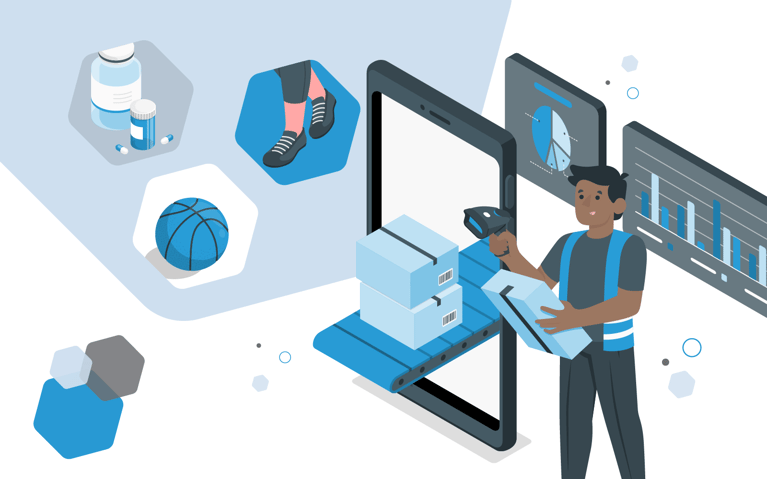Originally posted 6/8/2023, updated 1/25/2024 by A. Wolfe
Over the last five years, ecommerce growth has been among the top discussions across the logistics space. Historically, logistics providers were set up to move inventory between suppliers and retail stores, not to ship direct-to-consumer (DTC), via online marketplaces or dropship. However, the rise of ecommerce changed the logistics landscape, forcing an evolution in how fulfillment is done.
The addition of new channels – which have very different requirements than traditional retail – have put pressure on legacy 3PLs to expand their capabilities. At the same time, fast-growing digital native brands have expanded or are expanding into brick-and-mortar, placing an equal amount of pressure on newer 3PLs and fulfillment providers to similarly broaden their offerings.
As a provider that was born omnichannel, we pride ourselves on being able to help our customers address common omnichannel logistics problems. We’ve rounded up seven of the top challenges we hear about when speaking with new customers – and what you should look for when selecting a logistics provider to support your operations across channels.
1. Lack of omnichannel expertise
A lot of commentators like to draw distinctions between mature and up-and-coming merchants, but we see both struggle with omnichannel commerce. On one hand, a fast-growing D2C brand may lack brick-and-mortar experience. On the other hand, a large retailer may have a nascent ecommerce presence. Presuming you can outperform in a new channel because you’ve succeeded at another can be costly presumption.
Past performance is not indicative of future results. Without in-house expertise or the support of consultants and advisors, companies can easily choose the wrong logistics partner. Because of the importance of omnichannel coverage today, many 3PLs and fulfillment providers will say they can support multiple channels, but don’t have the expertise to achieve high SLAs consistently. Also, one omnichannel merchant can be very different than the next, not only in their SKU type and count, but also in terms of what channels they sell through. Similarly, one retailer or channel may have radically different requirements than the next one. This is particularly true with products that are regulated or require special handling, such as pharmaceuticals, food, chemicals and electronics.
Ensuring providers have expertise in your industry – and all required certifications – is critical. If you don’t have in-house expertise in the logistics requirements of a new channel, we encourage you to hire an outside consultant. There are a host of logistics consultants whose job it is to educate and empower their clients and help them choose the right 3PL.
2. Omnichannel inventory visibility
Just as the operational requirements across channels vary, the systems and data that are required to master omnichannel commerce can differ. The result is a lack of accurate, real-time inventory visibility across channels. To master omnichannel commerce, merchants need to know how much of every SKU is in their distribution facility, in a third party direct-to-consumer fulfillment facility, in their stores, in the FBA network, and so forth. However, legacy systems over encumber merchants’ ability to achieve a comprehensive view of their inventory across channels, providers and locations. Larger companies may invest in middleware and connectors. Smaller companies may handle this challenge manually. Both are suboptimal.
A single source of inventory truth that provides visibility and inventory management capabilities and that deeply integrates to a few key external systems is ideal. Not all 3PLs, however, have such systems – and many merchants are forced to cobble together tech stacks from different providers to accomplish this.
As a digitally and physically native provider, Cart.com has its own Order Management System (OMS) and Warehouse Management System (WMS) that provides order, inventory and operational visibility and reporting to our customers, all alongside our analytics capabilities that provide AI-driven predictive inventory and demand forecasting.
3. Manual inventory management and forecasting
We still encounter companies of all sizes that manually forecast stockout and overstock scenarios in Excel using primarily – and sometimes only – historical data. This becomes particularly cumbersome when selling across channels, where the sell-through rates, seasonality, marketing strategies, promotions, inventory volumes and velocities may vary across channels. While we love Excel, there are more modern tools and approaches to predicting demand, sell-through and future inventory levels.
Today’s merchants can leverage real-time signals from their marketing and advertising campaigns, click-through data, web traffic and clickstream data, multitouch attribution data, inventory data, shipping data and, yes, historical data to forecast inventory and demand. By layering in artificial intelligence (AI) and machine learning based methods and models, software can provide predictive insights and prescriptive recommendations to help you manage inventory and prevent stockout and overstock situations across various channels.
While concerns about algorithmic accuracy and error rates are valid, serious solutions will also provide confidence levels for each prediction or recommendation, helping to inform your decisions, not take them over. Additionally, machine learning-based approaches will learn from their victories and mistakes, improving their accuracy rapidly.
4. Fragmented or siloed order management
For single-channel brands, when an order comes in, they know exactly where it came from and where it needs to go. They’re only selling in one channel and their entire logistics and fulfillment operation is designed to support that single channel. In an multichannel or omnichannel scenario, however, orders come in from a handful or maybe even several sources and often need to be routed to different, disconnected providers so that they can be fulfilled in the right way and shipped to the right customer. This might not pose a huge problem if the brand has siloes for each of its channels, where one set of software and logistics providers serve one channel and a whole different set of systems and providers serve another. This setup, however, creates tremendous redundancy and cost. The seller in this case is effectively duplicating similar costs per channel, hindering scalability and efficiency.
Ideally, the merchant would be able to consolidate and integrate operations where possible and rely on distributed order management to properly unify and route orders appropriately across disparate systems, providers and facilities. Accomplishing this, however, requires distributed order management system (OMS) that is:
- A) designed to support multiple channels
- B) designed to support multiple locations and nodes
- C) designed to support integrations with different systems within a company and across its vendor base
- D) for fast-growing, mid-market and enterprise merchants, the software has to have been designed with complex logistics needs in mind.
Very few OMS check all these boxes and the ones that do are often cost prohibitive to most merchants, require lengthy deployment and integration times and aren’t as modern and cybersecure as they ought to be. We recommend looking for a Distributed Order Management application (DOM) like Cart.com’s, which covers all of these bases with an eye toward cybersecurity.
5. Disconnected transfers between providers
As sellers add more channels, the number of potential handoffs grows. They may have a central distribution center that replenishes stores, the FBA network and their D2C fulfillment provider. However, instances often arise where inventory needs to go from one to another. Additionally, the merchant may want their inventory to go right from port of discharge through the customs process to one of these vendors or directly to a forward stocking location closer to the customer. Once it’s in one of these vendors’ facilities, it still must matriculate into the carrier’s network, typically through one or more sortation or consolidation facilities. This creates a lot of potential handoffs that can slow down, disrupt or even interrupt the flow of goods from the factory floor to the customer’s door. This is a risk even when operating within a single channel.
When you start adding channels, these relationships can become even more complex. Tight technological and process integration among and between your logistics providers – from 3PLs to last-mile carriers – is critical to ensure seamless transfer of inventory from vendor to vendor. Logistics providers with close, longstanding relationships with first- and last-mile carriers are a plus, particularly as you’re scaling across channels.
6. Split shipments and merge-in-transit issues
We’ve all experienced split shipments where one order arrives in multiple boxes perhaps over multiple days. This is inconvenient at best. At worst, if the shipments are components of a single item, it can delay your ability to enjoy your purchase.
Split shipments can occur when there isn’t enough inventory on-hand to ship the full order or items in the order are coming from separate destinations. Rather than make your customer wait for inventory or for items to be consolidated in one or an entirely different facility (merged in transit), many merchants ship whatever they have when the order comes in.
This challenge becomes more acute when you have numerous SKUs being sold across many channels with the support of multiple providers. This is where a priori cross-channel inventory visibility is valuable. The best cure of split shipments is prevention through intelligent inventory forecasting and order management systems that are aware of all the inventory across providers. It’s also important that front-end points of sale are aware of split shipment scenarios so you can set that expectation with the customer up-front.
Alternatively, a truly omnichannel logistics provider can support all of your logistics and distribution needs from within a single facility or network, which can help avoid split shipments. That’s why Cart.com has built out a network of omnichannel fulfillment facilities, so our customers can streamline their operations and deliver a better experience to their customers.
7. Cumbersome returns process
Returns and returns management can be a huge hassle for merchants. Unfortunately, they’ve become the norm, particularly in industries like fashion and apparel where shoppers will order multiple items in different sizes or colors and return the ones they don’t want. In omnichannel situations, customers expect to be able to buy online and return in store (BORIS), which requires integration between ecommerce and brick-and-mortar POS systems, not to mention the order systems and ERPs behind them. This type of return behavior can lead to dislocation of inventory, and fast.
Efficient returns processing that allows inventory to be redeployed where it needs to be or that changes the amount of inventory allocated for various channels is critical in multichannel commerce. Many 3PLs offer returns management and some reverse logistics, but the ideal partner is one that has the software and physical infrastructure required to support returns and reverse inventory management at-scale. While some retailers have allowed customers to keep unwanted items because processing their return can be more costly than the item, you don’t have to settle for waste. The right processes, technologies and partners can help you make returns convenient for your shoppers without burdening them with unwanted product and compounding your opportunity cost of items that can’t then be resold.
Mitigating common logistics challenges with an omnichannel 3PL solution
These seven challenges are prevalent among both multichannel and omnichannel companies, cutting across merchants of all sizes. While the situations that give rise to these challenges may be different for enterprise D2C customers than for mid-market D2C customers, or for B2B vs B2C customers, the solutions are very much the same.
If you find yourself grappling with these multichannel commerce challenges or others, feel free to reach out. Our 3PL and contract logistics services, coupled with our proprietary order management software, are designed to seamlessly support every channel. Our dedicated experts are ready to collaborate with you, ensuring success on any channel you choose for your sales. Contact us today.
Subscribe to our emails for the latest industry insights!
By entering your email, you agree to receive marketing emails from Cart.com






